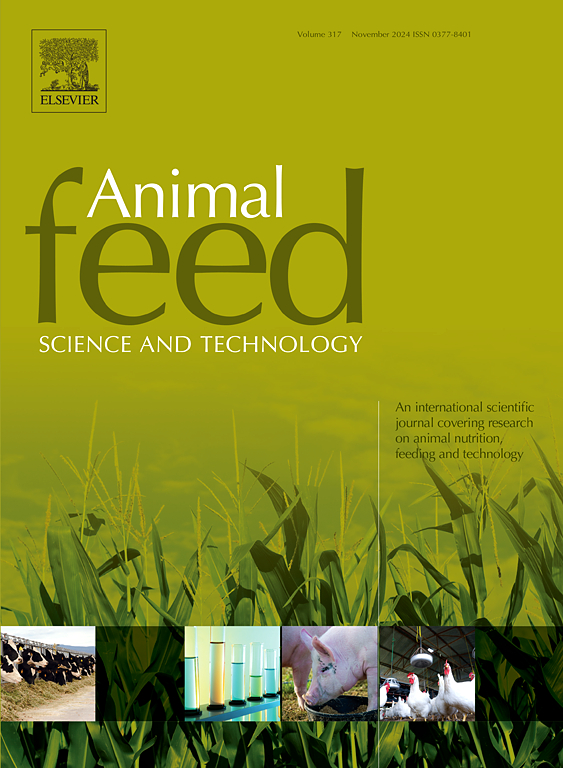Synergistic effects of Emblica officinalis with optimized synbiotic formulation on the growth and neonatal health of Murrah buffalo calves
IF 2.7
2区 农林科学
Q1 AGRICULTURE, DAIRY & ANIMAL SCIENCE
引用次数: 0
Abstract
This study was conducted to determine the synergistic effect of Emblica officinalis with optimized synbiotic formulation (Cichorium intybus and Ligilactobacillus salivarius BF17) on the growth, faecal microbiota, antioxidant and immunological status of Murrah buffalo calves. A synbiotic (comprising Cichorium intybus and Lg. salivarius BF17) and the phytobiotic powder of Emblica officinalis were selected for an animal experimental duration of 60 days. Twenty Murrah buffalo calves (5–7 days old) were assigned in a completely randomized design into four treatment groups as follows: Group I served as control (CON) supplemented with basal diet only, and Group II (SYN) was fed a synbiotic formulation comprising Lg. salivarius BF17 at 108 CFU/g/d/calf and Cichorium intybus L. (chicory) root powder at 8 g/d/calf; Group III (PHY) was provided with phytobiotic Emblica officinalis powder at 8 g/d/calf; and Group IV (COMB) received a combination consisting of synbiotic (Lg. salivarius BF17 and Cichorium intybus), and phytobiotic Emblica officinalis powder at similar doses. Body weight (BW) was recorded weekly. Faecal score was recorded daily, whereas faecal pH and faecal microbiota were estimated fortnightly. Faecal metabolites and antioxidant status was estimated at monthly intervals. The results revealed that the COMB group performed best in terms of growth, followed by the SYN and PHY groups, whereas the CON group had the lowest performance. In contrast to those in the CON group, all the supplemented groups showed a decrease (P < 0.05) in the faecal pH, faecal score, and ammonia concentration along with concurrent increases in the faecal lactate and short chain fatty acids (SCFAs) levels and further, the beneficial effects were more pronounced in the COMB group. Faecal Lactobacillus and Bifidobacterium population were significantly (P < 0.05) greater in the COMB, SYN, and PHY groups than the CON group, with a significant (P < 0.05) reduction in E. coli counts in the COMB and PHY groups. Super oxide dismutase (SOD) activity and immunological status (humoral immune response and cell mediated immune response) were greater (P < 0.05) in the COMB group than the CON group. Overall, this study revealed that Emblica officinalis has synergistic effects with synbiotic and improves the growth and neonatal health of Murrah buffalo calves.
优化合成制剂对穆拉水牛犊牛生长和新生儿健康的协同效应
本试验旨在研究石斛与优化合成制剂(菊苣和唾液脂乳杆菌BF17)对默拉水牛犊牛生长、粪便微生物群、抗氧化和免疫状况的协同效应。一种由菊苣和菊苣组成的合生植物。选取salivarius BF17)和Emblica officinalis植物粉进行动物实验,实验期为60 d。选取20头5 ~ 7日龄的默拉水牛,采用完全随机设计分为4个处理组:1组为对照(CON),仅添加基础饲粮;2组(SYN)饲喂含Lg的合成制剂。唾液BF17添加量为108 CFU/g/d/头,菊苣根粉添加量为8 g/d/头;第三组(PHY)以8 g/d/头的剂量给予植物性牛腹菌粉;第四组(COMB)接受由合成菌(Lg;salivarius BF17和chichorium intybus),以及植物制剂Emblica officinalis粉。每周记录体重(BW)。每天记录粪便评分,每两周估计粪便pH值和粪便微生物群。每个月评估一次粪便代谢物和抗氧化状态。结果显示,COMB组在生长方面表现最好,其次是SYN组和PHY组,而CON组的性能最低。与CON组相比,所有添加组的粪便pH、粪便评分和氨浓度均降低(P <; 0.05),粪便乳酸和短链脂肪酸(SCFAs)水平均升高,且COMB组的有益效果更为明显。梳子组、SYN组和PHY组的粪便乳酸菌和双歧杆菌数量显著高于CON组(P <; 0.05),梳子组和PHY组的大肠杆菌数量显著降低(P <; 0.05)。COMB组超氧化物歧化酶(SOD)活性和免疫状态(体液免疫反应和细胞免疫反应)高于CON组(P <; 0.05)。综上所述,本研究表明,黑刺草与合生剂具有协同效应,可促进默拉水牛幼崽的生长和新生儿健康。
本文章由计算机程序翻译,如有差异,请以英文原文为准。
求助全文
约1分钟内获得全文
求助全文
来源期刊

Animal Feed Science and Technology
农林科学-奶制品与动物科学
CiteScore
6.00
自引率
6.20%
发文量
266
审稿时长
3 months
期刊介绍:
Animal Feed Science and Technology is a unique journal publishing scientific papers of international interest focusing on animal feeds and their feeding.
Papers describing research on feed for ruminants and non-ruminants, including poultry, horses, companion animals and aquatic animals, are welcome.
The journal covers the following areas:
Nutritive value of feeds (e.g., assessment, improvement)
Methods of conserving and processing feeds that affect their nutritional value
Agronomic and climatic factors influencing the nutritive value of feeds
Utilization of feeds and the improvement of such
Metabolic, production, reproduction and health responses, as well as potential environmental impacts, of diet inputs and feed technologies (e.g., feeds, feed additives, feed components, mycotoxins)
Mathematical models relating directly to animal-feed interactions
Analytical and experimental methods for feed evaluation
Environmental impacts of feed technologies in animal production.
 求助内容:
求助内容: 应助结果提醒方式:
应助结果提醒方式:


